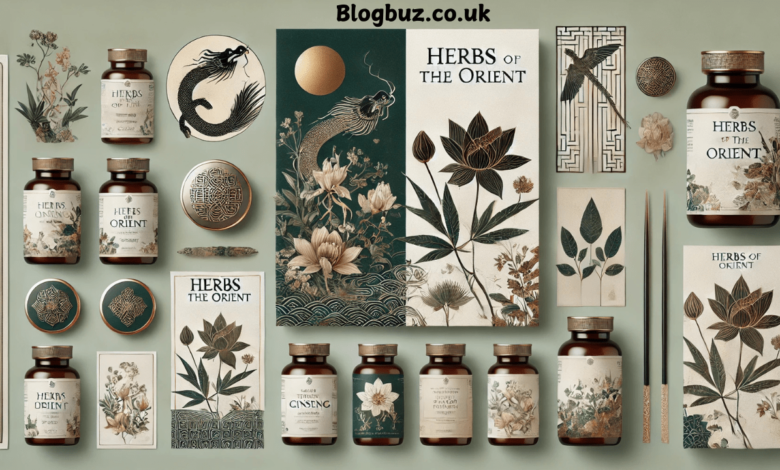Herbs of the Orient Brand Design: A Timeless Blend of Tradition & Modernity

In herbal remedies, skincare, and wellness products, Herbs of the Orient has become a recognizable theme in brand design. With its deep roots in ancient traditions and a growing market of consumers seeking natural solutions, the branding of such products must reflect both heritage and modernity. This article explores the key elements of Herbs of the Orient brand design, its impact on consumer perception, and how businesses can leverage effective design strategies to attract a global audience. Whether you’re an entrepreneur looking to create a herbal brand or a designer seeking inspiration, this guide will provide valuable insights.
The Significance of Herbs of the Orient in Branding
Herbs of the Orient refers to traditional herbal medicines and natural products derived from Chinese, Japanese, Korean, and other Eastern healing practices. These herbs are often associated with longevity, wellness, and balance, which form the cornerstone of their branding identity.
The importance of branding in herbal businesses cannot be understated. A strong visual and conceptual identity sets a brand apart in a competitive market. Effective brand design should reflect the following:
- Cultural heritage – Honoring the traditional origins of the herbs.
- Natural elements – Emphasizing organic and holistic aspects.
- Modern elegance – Ensuring contemporary appeal for global audiences.
- Trust and credibility – Highlighting authenticity and quality assurance.
Core Elements of Herbs of the Orient Brand Design
Logo Design and Typography
A well-designed logo is the first visual element that consumers interact with. It should capture the essence of the brand while maintaining simplicity and sophistication.
Key Features of an Effective Logo:
- Minimalist yet intricate: Oriental branding often incorporates calligraphy-style fonts or symbolic plant motifs.
- Circular or organic shapes: Representing harmony and balance.
- Color psychology: Earthy tones such as deep green, rich brown, muted gold, and soft beige often convey a connection to nature.
Packaging Design
Packaging plays a crucial role in attracting and retaining customers. A successful herbal product package should be aesthetically appealing and functional.
Packaging Design Principles:
- Sustainable Materials: Many herbal brands use biodegradable or recycled packaging to reinforce their environmental commitment.
- Elegant Typography: Traditional Eastern scripts or carefully chosen fonts that reflect an ancient-modern fusion.
- Herbal Illustrations: Hand-drawn or watercolor-style illustrations of key herbs like ginseng, goji berries, ginger, and turmeric add authenticity.
- Gold Foil & Embossing: These premium design elements are often used to elevate the luxury feel of the brand.
Color Palette and Aesthetic Choices
Colors play a significant role in conveying a brand’s story. In Herbs of the Orient branding, we often see a blend of:
- Deep Greens & Earthy Browns: Representing nature, growth, and sustainability.
- Muted Reds & Golds: Inspired by traditional Chinese medicine packaging, signifying prosperity and vitality.
- Soft Beige & Ivory Tones: Adding a minimalist, premium touch to appeal to modern consumers.
Cultural Symbolism in Branding
Traditional symbols are commonly incorporated into Eastern herbal brands to enhance authenticity. Some frequently used symbols include:
- Yin-Yang Elements: Representing balance and holistic well-being.
- Lotus Flowers: Symbolizing purity and spiritual enlightenment.
- Dragon & Phoenix Imagery: Often used for premium, high-end herbal supplements.
- Herbal Icons (Ginseng, Bamboo, Leaves): Reinforcing the botanical nature of the products.
Website & Digital Branding
In the digital age, having a strong online presence is crucial. A well-structured website and social media branding should align with the visual elements of the packaging and logo.
Best Practices for Online Branding:
- Clean, minimal website design that emphasizes natural ingredients.
- High-quality imagery of herbs, plants, and people using the products.
- User-friendly navigation with an easy-to-explore product catalog.
- SEO-friendly content, including blogs on herbal benefits, ancient remedies, and wellness tips.
Successful Brands & Case Studies
Oriental Herb Company
Oriental Herb Company (OHC) has successfully blended tradition with modern aesthetics. Their branding uses a combination of vintage-inspired fonts, herbal illustrations, and natural color schemes to emphasize authenticity.
Oriental Princess
This Thai-based brand focuses on beauty and skincare products infused with Eastern herbal extracts. Their packaging features sleek typography, floral patterns, and soft pastel tones, making their products visually appealing and premium.
Herb & Design’s Orient Collection
A candle and wellness brand that uses a minimalist yet elegant approach. Their branding revolves around serene aesthetics, Japanese-inspired simplicity, and hand-drawn elements to establish a luxury appeal.
How to Create a Distinctive Brand Identity for Herbs of the Orient
Define Your Brand’s Story
Consumers connect with brands that have a compelling backstory. Whether it’s the ancient wisdom of Chinese medicine or the healing power of Ayurvedic herbs, your brand should communicate a resonant narrative.
Prioritize Authenticity
Avoid generic designs that look mass-produced. Instead, invest in custom illustrations, high-quality materials, and ethical sourcing to enhance credibility.
Use Consistent Branding Elements
From product packaging to social media posts, ensure your brand maintains a cohesive aesthetic across all platforms.
Leverage Digital Marketing & SEO
Optimizing your website for SEO keywords like “Herbs of the Orient,” “best herbal remedies,” and “natural wellness products” can drive organic traffic and improve visibility.
Conclusion
The Herbs of the Orient brand design fuses tradition, nature, and modern sophistication. By incorporating cultural heritage, natural aesthetics, and strategic marketing, brands can establish a strong presence in the herbal industry.
For businesses looking to enter this space, authenticity, sustainability, and storytelling will be key to standing out. Whether it’s premium herbal teas, skincare solutions, or wellness products, ensuring a well-crafted brand identity can lead to long-term success.
You May Also Read: TheHealthyPrimates.org/: Your Guide to Holistic Health, Wellness, and Self-Care




